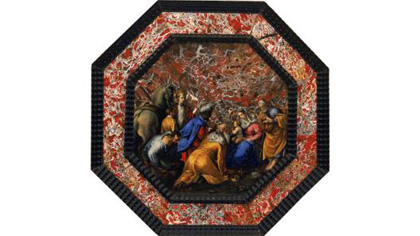The Adoration of the Magi
The Adoration of the Magi, ca. 1565
Jacopo da Ponte Bassano
Italian (Venice)
Oil on Verona marble laid on slate
Gift of the Friends of Fr. Donald Rowe, S.J., 1991-02
Bassano executed this painting on Verona marble, masterfully integrating the pattern of the marble into his composition. In the tradition of Venetian painters, Bassano was highly regarded for his brilliant manipulation of light and color. For example, in the D'Arcy octagonal marbles, Bassano has harmonized vibrant blues and yellows with the sublime roses and whites of the background surface. The preciousness of material and the treatment of the figures represent a courtly style of painting called Mannerism. The figures are highly elegant, graceful, and peculiarly elongated. The sophistication of Italian Mannerism, as well as the sumptuous marble and ebony used by Bassano, appealed especially to aristocratic patrons. Bassano employed this particular composition several times, although utilizing other supports including panel and canvas.
Bassano's marble recounts an important event surrounding the birth of Christ, the Adoration of the Magi. Bassano has portrayed his Magi in their traditionally elegant and exotic garb. Commanded by Herod, the Magi followed a star from the East to seek the purported New King of the Jews. The star led the Magi to Bethlehem, where they found the Christ Child. With his back to the viewer and having removed his crown, Caspar, the oldest Magi, kneels before the infant Jesus. Caspar wears a resplendent gold robe trimmed with ermine, a fur reserved for royalty. In the center, in profile, is turbaned King Balthasar. To his left, standing and facing the viewer, is the youngest of the Magi, Melchoir. According to legend, the Magi brought gifts of gold, symbolizing Christ's kingship; frankincense, referring to His divinity; and myrrh, foreshadowing Christ's crucifixion, as myrrh was used in embalming.



